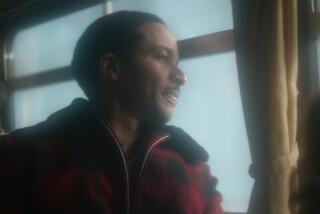The Face of Individuality
- Share via
Every episode of “The Twilight Zone” was meant to unsettle you, one way or another. But one in particular stalked through my dreams: a teenage girl in some future homogeneous techno-culture resisting the rite-of-passage surgery that would turn her ordinary, yet piquant, face into one like every other woman’s: beautiful but cookie-cutter bland. At last she yielded, and the girl who came out at the other end of the process had not just a changed face but a changed outlook as well, a conformist spirit.
I thought of that episode again when I heard that pinch-hitter Matt Luke was back with the Los Angeles Dodgers--because both of us, Matt Luke and I, have felt like that teenage girl, the “before” model, in “The Twilight Zone.”
Luke was born with a large facial birthmark that doctors call congenital hairy nevus and the pop culturists call human werewolf syndrome. I was born with a dark-red birthmark called Sturge-Weber. His was more serious, more shocking than mine. They say looks matter less in a boy than a girl, but as much as the concern is about looks, it’s even more about being different.
Kids are painfully forthright. They will mock anything different--or anyone. Adults are subtler, but somehow their slyness can be more hurtful. It’s why Luke had six surgeries before he said “enough” and stopped. The funny thing is that at age 5 or 6 or 12, you’d have given anything to be rid of it. (“I didn’t want this thing on my face . . . it made me feel emotions I didn’t want to feel,” Luke says.) Yet when you grow up, however long that takes, you realize you wouldn’t give it up--that deformity, that difference--for anything.
“It made my character,” says Luke, now 27. “When people look at me, I want them to see my birthmark. It definitely helped me be who I am today . . . . I don’t want to look like John Doe. And it takes maturity to realize that.”
I’d never met matt luke, and, truth to tell, I don’t even like baseball. But 10 minutes into our talk, we were finishing each other’s sentences, so parallel is the experience of growing up having something on our faces that other people don’t. We enumerated the same five or six reactions it elicited--curiosity, concern, rudeness, shock, mockery and such--and the same struggle in the eyes when people were trying not to be seen seeing and reacting . . . and the several answers we’d give, depending on whether the people were nice about it, or whether we felt congenial that day, or mischievous, or just plain peeved.
We employed the same little tricks. I’d strike a pose I once saw in a Victorian painting: concealing the right side of my face by resting it languidly on my open hand. Luke used to sit in a room--at school, elsewhere--”and I would turn what I thought was my more attractive side so the rest of the world got to see what they thought was beautiful and not ugly. Now when people look at me, I want them to see my birthmark.”
Without his birthmark, heck--his toughest challenge might have been being a blue-blooded Dodger fan growing up 10 minutes from Anaheim Stadium.
*
After a Times sports column discussed Luke’s face and CNN did a story, the mail cascaded in, not necessarily from fans of his batting prowess but of his face, of the story and the man behind it. And not just kids wrote. A 54-year-old woman who moves her disfigured face from darkened corner to darkened corner wanted him to know how brave he is and how she’d like to be brave, too. To all of them, he says: “It makes us unique, makes us rare and special individuals. Once we understand that, once we can be happy [with] who we are, we are different from everyone in the entire world and use it as a plus in our lives, rather than worrying about it.”
He bears the names of two of the four apostles, which for a Christian must be like being expected to bat .500 on all the virtues. But he wouldn’t be the man or the Christian he is today without that face and the platform it gives him. “It made me want to treat people in a way that I wanted to be treated . . . . I’m very careful, very sensitive to other people’s feelings because of how I felt about my own.”
He tells the people who write that everyone is good at something, and it’s only a matter of finding it. “It’s baseball with me,” he tells me. “It’s writing with you . . . . As you grow in life, you see you’re good in things, and once you decide that thing you want to do, you start concentrating on the things you love in life and being less self-conscious about how you look.” He tells them to forget about surgery, about hiding or covering up, but that’s difficult; as a child you feel your face walks three feet in front of you, a megawatt brass band. With such a birthmark, I know, there’s no pain on the inside. The pain comes from the world outside, and it is not physical.
But no surgery can guarantee a sense of self. He didn’t have that sense at 10, or at 15. He just acquired it a few years ago, and not through a scalpel or a surgical laser. “Every kid out there has something [to overcome]. Mine just happens to be in the middle of my face.”
More to Read
The complete guide to home viewing
Get Screen Gab for everything about the TV shows and streaming movies everyone’s talking about.
You may occasionally receive promotional content from the Los Angeles Times.






